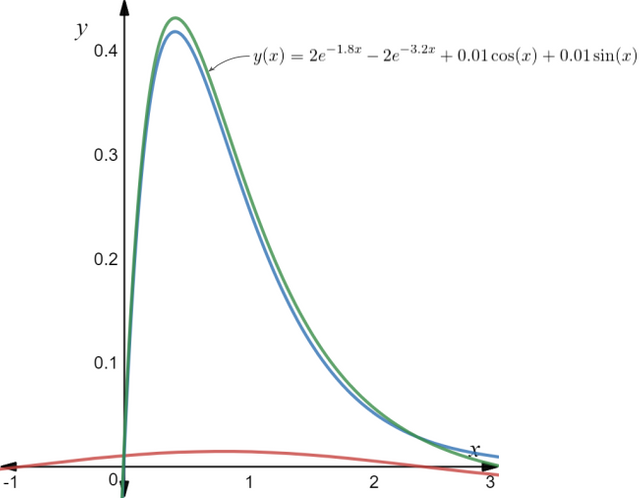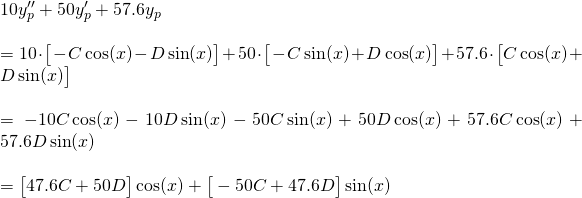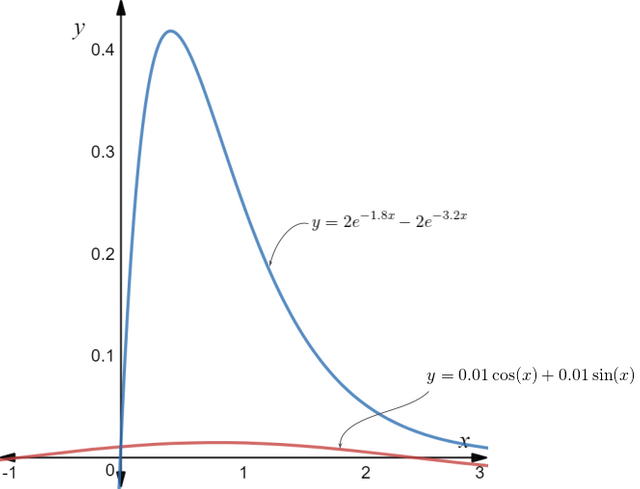Solving Non-homogeneous ODE's: Method of Undetermined Coefficients Part 3
In this post, we'll work through yet another example of the method of undetermined coefficients for solving non-homogeneous ordinary differential equations.

Figure 1. The particular solution to equation (1) depicted by the green curve
This time the non-zero term r(x) is an oscillating, trigonometric term. So let's go straight to example 3...
Example 3
Let's find the solution to...

...with initial conditions...

As always, we first find the solution to the homogeneous equation...

The characteristic equation of (2) is...

And the roots of (3) are...


Thus we have 2 distinct, real roots. So by equation (3) of Post #3, the general solution to the homogeneous solution is...

Now for the particular solution to the non-homogeneous equation, let's try a solution of the form...

Applying the first and second derivatives, we get...

So let's now substitute these solutions into (1) and see what happens. The left hand side becomes...

Now, can you see a problem here? What happens when we equate the two sides?

If we now equate the coefficients, we get the nonsensical results that  and
and  . We know that the constant C cannot simultaneously hold 2 different values.
. We know that the constant C cannot simultaneously hold 2 different values.
So simply using a single trig term didn't work. What if we expand the particular solution to include a  term as well? Let's try...
term as well? Let's try...

...then...

Let's now substitute these solutions into (1) again, and the left hand side works out to become...

And equating this to the right hand side...

And again, equating the coefficients, we have...

Solving for C and D simultaneously, we get...

Therefore the particular solution to the non-homogeneous equation is...

Now, adding the homogeneous and non-homogeneous solutions, we have the general solution to equation (1)...

Applying the initial conditions to (4)...


Solving the above simultaneously, we get...

Thus finally, the particular solution to ordinary differential equation (1) is...

The solution is composed of a low amplitude oscillating part from the non-homogeneous equation, and an exponential part from the homogeneous equation. In Figure 2 below, we have a plot of the two separate components in maroon and blue respectively.

Figure 2. Components of the particular solution
You can see by Figure 1 above, that the low amplitude oscillating component doesn't have much of an influence on the solution at all, as depicted by the curve in green.
Credits:
All equations in this tutorial were created with QuickLatex
First Order Differential Equations
- Introduction to Differential Equations - Part 1
- Differential Equations: Order and Linearity
- First-Order Differential Equations with Separable Variables - Example 1
- Separable Differential Equations - Example 2
- Modelling Exponential Growth of Bacteria with dy/dx = ky
- Modelling the Decay of Nuclear Medicine with dy/dx = -ky
- Exponential Decay: The mathematics behind your Camping Torch with dy/dx = -ky
- Mixing Salt & Water with Separable Differential Equations
- How Newton's Law of Cooling cools your Champagne
- The Logistic Model for Population Growth
- Predicting World Population Growth with the Logistic Model - Part 1
- Predicting World Population Growth with the Logistic Model - Part 2
- What's faster? Going up or Coming Down?
First order Non-linear Differential Equations
- There's a hole in my bucket! Let's turn it into a cool Math problem!
- The Calculus of Hot Chocolate Pouring!
- Foxes hunting Bunnies: Population Modelling with the Predator-Prey Equations
Second Order Differential Equations
- Introduction to Second Order Differential Equations
- Finding a Basis for solutions of Second Order ODE's
- Roots of Homogeneous Second Order ODE's and the Nature their Solutions
- Modelling with Second Order ODE's: Undamped Free Oscillations
- Modelling Car Suspension with ODE's: Damped Free Oscillations Part 1
- Modelling Car Suspension with ODE's: Damped Free Oscillations Part 2
- Modelling Car Suspension with ODE's: Damped Free Oscillations Part 3
- Non-homogeneous Differential Equations
- Solving Non-homogeneous ODE's: Method of Undetermined Coefficients Part 1
- Solving Non-homogeneous ODE's: Method of Undetermined Coefficients Part 2
- Solving Non-homogeneous ODE's: Method of Undetermined Coefficients Part 3
Please give me an Upvote and Resteem if you have found this tutorial helpful.
Feel free to ask me any math question by commenting below and I will try to help you in future posts.
Tip me some DogeCoin: A4f3URZSWDoJCkWhVttbR3RjGHRSuLpaP3
Tip me at PayPal: https://paypal.me/MasterWu
This post has been voted on by the SteemSTEM curation team and voting trail in collaboration with @curie.
If you appreciate the work we are doing then consider voting both projects for witness by selecting stem.witness and curie!
For additional information please join us on the SteemSTEM discord and to get to know the rest of the community!
As a follower of @followforupvotes this post has been randomly selected and upvoted! Enjoy your upvote and have a great day!
Congratulations @masterwu! You have completed the following achievement on the Steem blockchain and have been rewarded with new badge(s) :
Click here to view your Board of Honor
If you no longer want to receive notifications, reply to this comment with the word
STOPDo not miss the last post from @steemitboard: